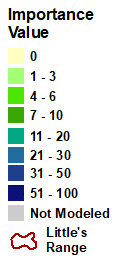silverbell (Halesia spp.)
Model Reliability: Low
| GCM SCENARIO | % Area Occ | Ave IV | Sum IV | Future/Current IV |
|---|---|---|---|---|
| Actual | 0.2 | 2.1 | 150 | N/A |
| RFimp | 0.6 | 0.6 | 106 | 0.71 |
| CCSM45 | 2 | 0.2 | 147 | 1.39 |
| CCSM85 | 3.2 | 0.2 | 181 | 1.7 |
| GFDL45 | 4.7 | 0.1 | 202 | 1.91 |
| GFDL85 | 4.8 | 0.1 | 179 | 1.69 |
| HAD45 | 2.1 | 0.2 | 133 | 1.25 |
| HAD85 | 1.3 | 0.3 | 131 | 1.23 |
| GCM45 | 6.6 | 0.1 | 161 | 1.52 |
| GCM85 | 6.6 | 0.1 | 164 | 1.54 |
Regional Summary Tree Tables
Summaries for tree species are available for a variety of geographies, in both PDF and Excel format. These summaries are based on Version 4 of the Climate Change Tree Atlas
Interpretation Guide
Silverbell is extremely sparse (0.2% of area), with low IV, which Little mapped in the Gulf states, but the FIA core area is only in western North Carolina. The poorly reliable model suggests no change of habitat within the southern states, and its rarity and moderate adaptability yielded a poor overall capability rating. SHIFT shows minor infill.
Family: Styracaceae
Guild: opportunistic, moderate growth, moist-site tolerant, understory tolerant
Functional Lifeform: Small deciduous tree
| 4.2 | 0.35 |
| -0.47 |  |
MODFACs
What traits will impact silverbell's ability to adapt to climate change, and in what way?:
Primary Positive Traits
Shade tolerance



